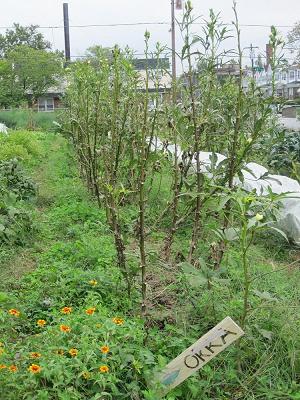
https://vimeo.com/20472161
A bright spot sprouts amidst a string of deteriorating row homes lining Brown Street in the Mantua neighborhood of Philadelphia.
The fresh patch of greenery located on the corner of 49th Street, known familiarly as Millcreek Farm, contrasts directly with the burnt chestnut coloring of the aged houses on the opposing corner. The once vacant lot stretches for roughly half a block, and on Saturdays the entrance floods with fresh produce available for purchase by locals. During one recent weekend when a dreary overcast hung over the neighborhood, residents still made the journey in search of fresh, affordable food. “I’ll have some of that okra,” murmurs a customer, as she points towards the bright green vegetable. It is quickly bagged, rung up, and she is on her way, dinner hanging from her wrist.

Locally grown, organic food is a trend increasing in popularity in many middle and upper class neighborhoods. Grocers like Whole Foods and Trader Joe’s brag about their fresh food brought in from surrounding counties. Yet neighborhoods, like Mantua, have limited access to the basics of nutrition. Instead, reliance is put on corner stores and local restaurants, where vegetables rarely make an appearance. “There’s a real disconnect with people understanding where food comes from and how to grow it,” said Jade Walker of Millcreek Farms. “If you want to access fresh food, you can’t do that.”
But with many residents noticing the shortage of options, there has been progress in recent years. The Food Trust of Philadelphia, along with Millcreek, hosts a farmers’ market in the area every Wednesday and Friday afternoon. Preston’s Paradise, a smaller backyard farm run by duo Suzanna Urminska and Ryan Kuck, sells produce every Saturday morning to neighbors who stop by for the inexpensive fruit and vegetables. And the Urban Nutrition Initiative, run through University City High School, gives kids the knowledge and opportunity to farm in areas around the city.
“I see our farm being a model for how you can have local, healthy, freshly picked, organic produce in neighborhoods all across the city,” said Walker. “This city has an amazing amount of vacant land and there is a lot of opportunity there.”

Millcreek’s story began in 2005 when Walker and her friend Johanna Rosen noticed the significant lack of fresh produce in the area, and put in a grant proposal to combine the community garden and vacant lot in their neighborhood into a community farm. After receiving funding, the two worked hard to transform the space. “We used the money to grade the land. We used mushroom compost, planted fruit trees at every fence post, planted tons of vegetables,” said Walker. Workshops for local residents not only offered a helping hand in building everything from tool sheds to cob ovens, but also got neighbors interacting within the communal space.
The farm has worked hard to maintain non-profit status. Walker estimates funding is sourced roughly in thirds: private donations, grants and food sales. By obtaining around six grants a year from private foundations like Dowdy and the Hills Fund, Millcreek has ensured the prices of their produce are heavily subsidized. For residents who may not be able to afford many groceries, this is crucial. At $1.25 a pound, fresh red peppers are a steal compared to the $3 ones at the Save-A-Lot only a block away.
Now in its fourth growing season, Millcreek harvests many different types of produce. “By far our biggest seller is okra. A lot of the residents here are from the South, and you can still see those traditions in the way they cook,” said Walker. The fall season boasts a market stand bursting with bright tomatoes, red and green peppers, leafy greens, and their newest addition, sweet potatoes.

Most customers pay cash for their transaction, but Millcreek now accepts food stamps and WIC checks at the small market stand. By obtaining an Electronic Benefits Transfer [EBT] machine from the state, residents can present their food stamps in exchange for some of the homegrown vegetables.
Despite the hard work and dramatic changes Walker and her friend have brought to the neighborhood, there is still a long way to go. “The city really doesn’t do much to support us. The redevelopment authority says they support local farms, but there haven’t been any actions to support it,” says Walker. She notes that the city is willing to sign short-term leases, for about one to two years, so the land may be sold after it is developed. But her faith in the project keeps her going. The need for different sources of fresh produce is essential to the neighborhood.
Ryan Kuck, of Preston’s Paradise, agrees. “What we do does not make up for the lack of produce around here. There are no easily accessible whole foods markets offering a basic range of foods. We don’t compete with supermarkets. We need both,” he says.
And perhaps both will flourish. As these two farms make significant efforts into improving the availability of fresh fruits and vegetables, local residents have greater access to, and can afford, more nutritious food.
[soundslide url=”https://astro.temple.edu/~tua59526/mantuaqualityoflife/” height=550 width=600]


Now I am ready to do my breakfast, when having my breakfast coming again to read further news.